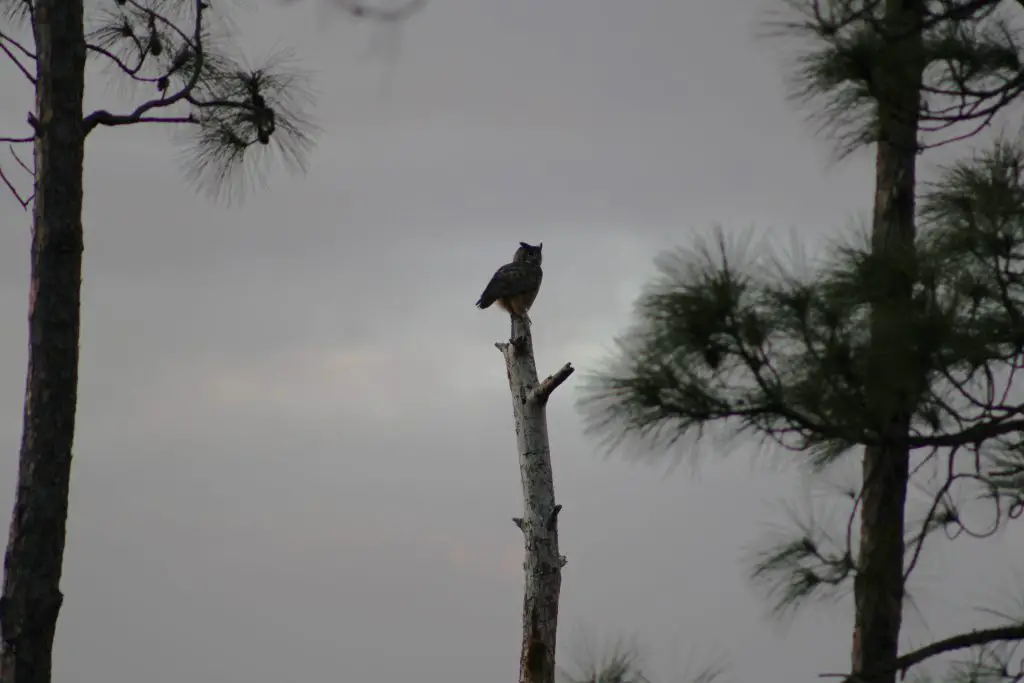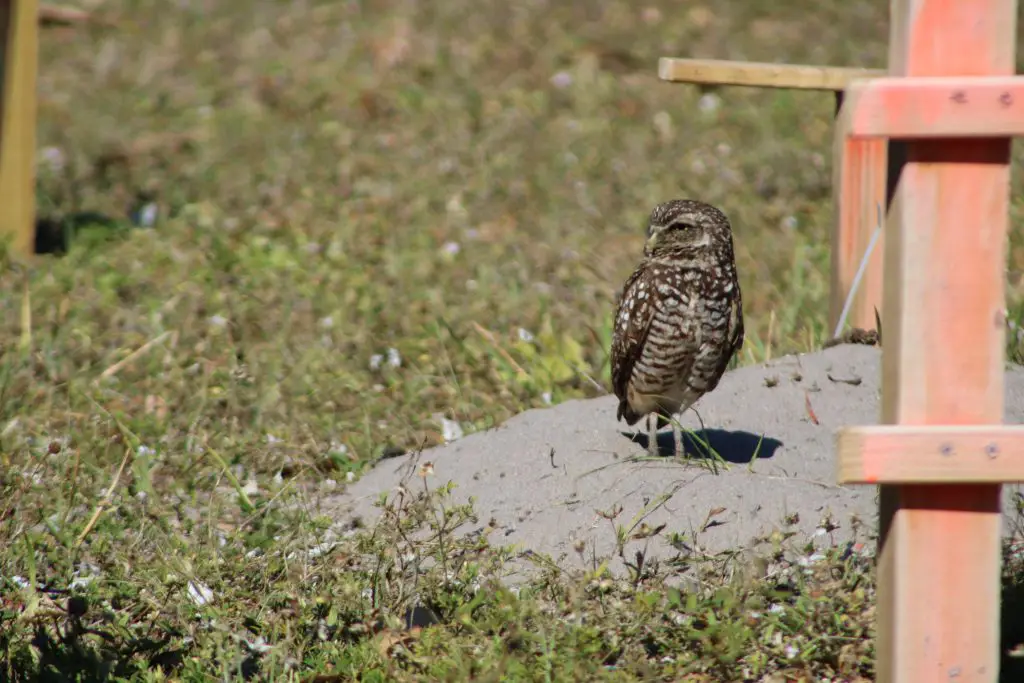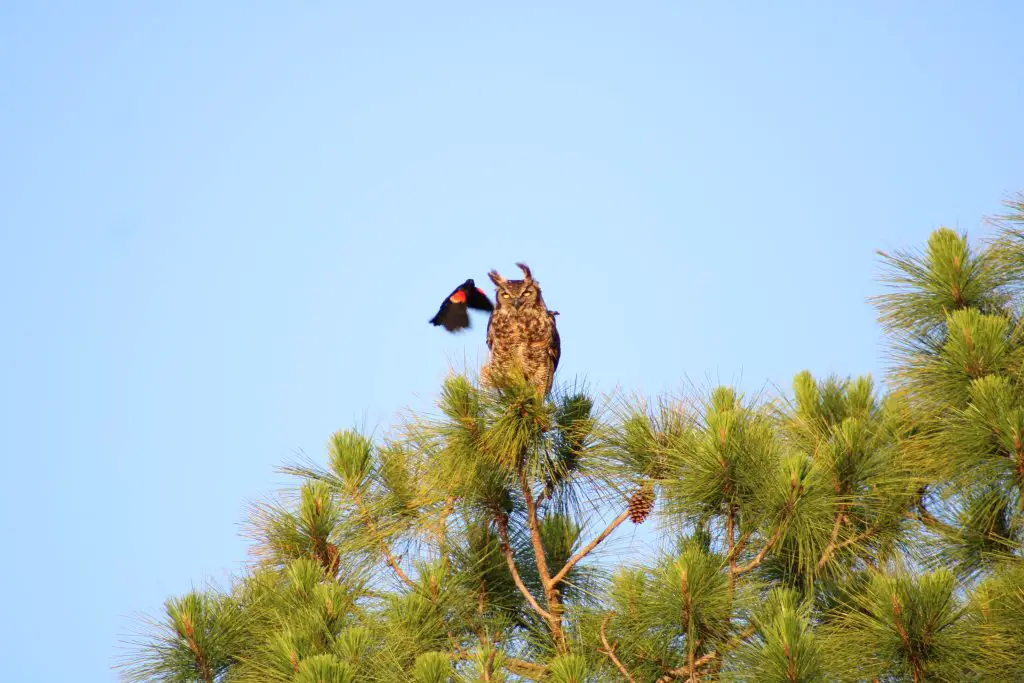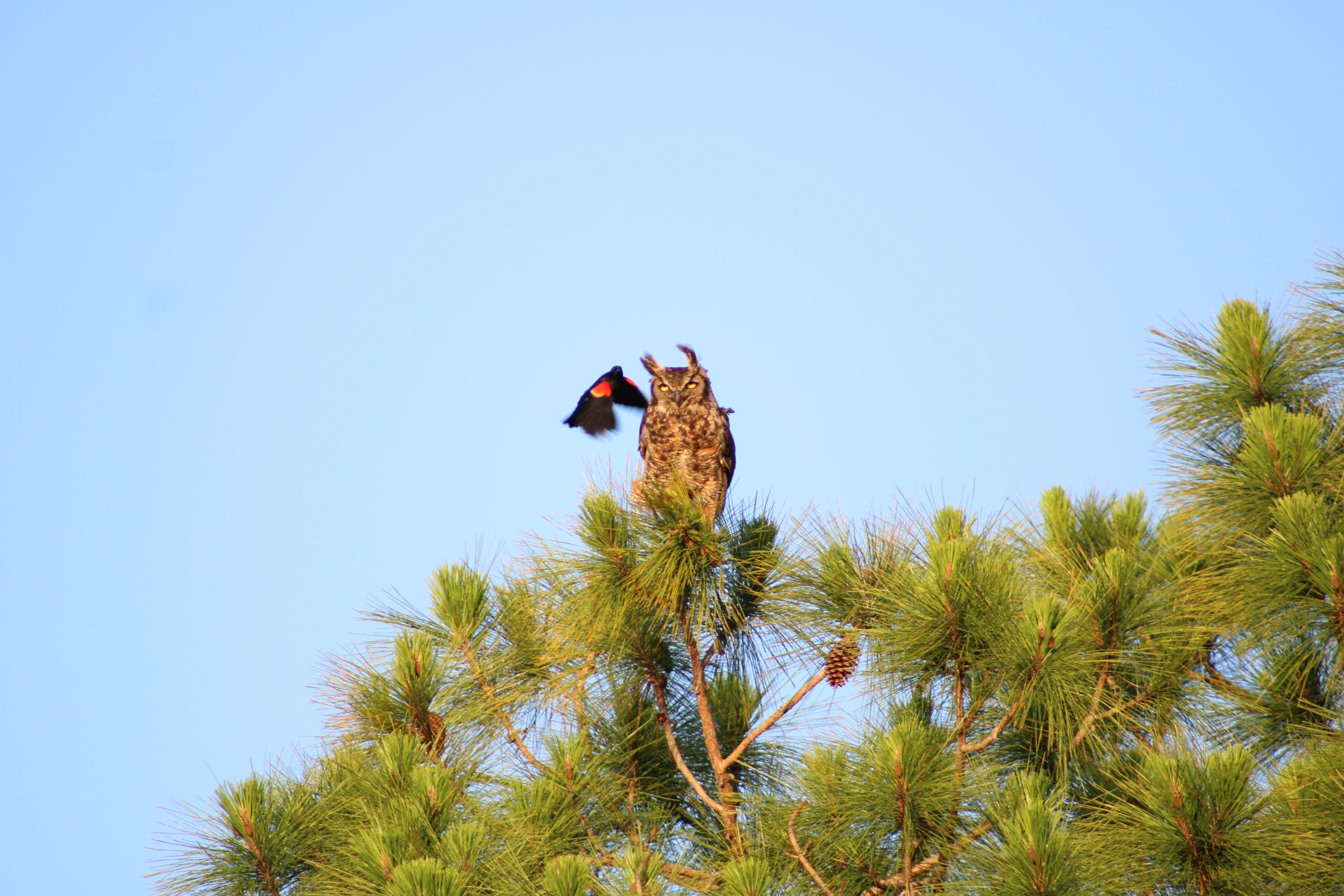Florida is home to a diverse range of wildlife, and among its most captivating residents are the owls. These nocturnal birds of prey have long captured the human imagination with their haunting calls, silent flight, and distinctive appearances. From the small, elusive Eastern Screech Owl to the mighty Great Horned Owl, Florida offers a variety of owl species that can be spotted across the state, in woodlands, wetlands, and even suburban areas.
In this guide, we’ll explore the owls of Florida. Hopefully, you learn something because these guys are a hoot ;)
Owls in Florida
You can find owls all over the Sunshine State. While several owl species float into the area now and then, I’ve only included owls that regularly come to Florida. I’ve seen almost all of these owls myself (I’ve only heard -not seen – the Screech Owl though).
Great Horned Owl

- Scientific name:Bubo virginianus
- Size: Typically ranges from 18 to 25 inches in length, with females generally larger than males.
- Weight: Average weight is between 2 to 5 pounds.
- Wingspan: 3.3 to 4.8 feet, making them one of the largest owls in North America.
- Nesting season: Usually begins in late winter or early spring, with eggs being laid from January to March.
The Great Horned Owl (Bubo virginianus) is one of the most iconic and widespread owl species in Florida. Known for its distinctive tufted “horns” (feathers that resemble ears) and powerful presence, the Great Horned Owl is a formidable hunter and a top predator in its environment. Its adaptability allows it to thrive in a variety of habitats across the state, from urban areas to remote forests.
Great Horned Owls are often spotted perched high in trees during the day, though they are primarily nocturnal, hunting at night. They play a crucial role in controlling populations of small mammals and other prey species, maintaining the balance of Florida’s ecosystems.
Personally, I love seeing these owls nest in my neck of the woods every spring. Their chicks get big quickly but they are so fluffy in the beginning.

Burrowing Owl

- Scientific name:Athene cunicularia
- Size: Typically ranges from 7.9 to 9.8 inches in length, making them one of the smallest owl species.
- Weight: Average weight is about 5.3 to 7 ounces.
- Wingspan: Approximately 21 to 24 inches, relatively short for an owl.
- Nesting season: Burrowing Owls typically begin their nesting season from March to June, depending on the region.
The Burrowing Owl (Athene cunicularia) is one of Florida’s most unique owl species, easily recognized by its small size and habit of living in underground burrows. Unlike most owls, which nest in trees or high structures, Burrowing Owls make their homes in the ground, often in abandoned burrows made by prairie dogs or other animals. These owls are primarily found in Florida’s grasslands, prairies, and even urban areas, making them a fascinating and sometimes surprising sight for residents and visitors.
In Florida, Burrowing Owls are often seen standing at the entrance to their burrows during the day, unlike many other owl species that are strictly nocturnal. They are known for their distinctive, wide-eyed stare and their unique “hoot” calls. Despite their small size, Burrowing Owls are effective hunters, preying on insects, small mammals, and even reptiles.
These owls are often a favorite among birdwatchers due to their approachable nature and unique behavior. However, their populations are facing threats due to habitat loss and human development. Conservation efforts in Florida have focused on preserving open spaces and burrowing sites to help protect these remarkable birds.
Eastern Screech Owl
- Scientific name: Megascops asio
- Size: Ranges from 6.3 to 9.8 inches in length, making them one of the smaller owl species in Florida.
- Weight: Average weight is 4.4 to 8.6 ounces.
- Wingspan: Approximately 18 to 24 inches.
- Nesting season: Typically from February to May, although it can vary slightly depending on the region.
The Eastern Screech Owl (Megascops asio) is a small, nocturnal owl species that is widespread throughout Florida. Known for their distinctive “screech” calls, which are actually a soft, whistling trill, these owls are well adapted to life in urban, suburban, and rural environments. Eastern Screech Owls have a wide range of plumage variations, including both gray and red morphs, allowing them to blend in with tree bark and foliage in their wooded habitats.
Unlike larger owls that hunt from great heights, Eastern Screech Owls prefer to nest in tree cavities and are often found near forest edges, suburban yards, or even in city parks. Despite their small size, they are proficient hunters, feeding on small mammals, insects, and birds.
Eastern Screech Owls are relatively solitary birds, and although they are primarily nocturnal, they can be active during the day, especially during the winter months. Their ability to camouflage within tree bark and their distinctive, high-pitched trill make them a fascinating species for bird enthusiasts and a crucial part of Florida’s ecosystem.
Barred Owl

- Scientific name: Strix varia
- Size: Typically ranges from 16 to 25 inches in length, making them one of the larger owl species in Florida.
- Weight: Average weight is between 1.1 to 1.6 pounds (500 to 700 grams).
- Wingspan: Approximately 39 to 43 inches.
- Nesting season: Generally begins from February to May, with peak activity in early spring.
The Barred Owl (Strix varia) is a large, striking owl species found in Florida’s forests, swamps, and wetlands. Recognized by its distinctive brown and white striped “bars” across its chest and a round face with dark eyes, the Barred Owl is a fascinating nocturnal predator. Known for their distinctive, hooting calls that sound like “Who cooks for you? Who cooks for you all?” these owls are often heard in the quiet of the night in the woodlands of Florida.
Barred Owls are highly adaptable and are commonly found in areas with dense tree cover, such as hardwood forests and wetlands. Unlike many other owl species that are more secretive, Barred Owls are relatively visible and can often be spotted perched in tree branches, hunting small mammals, amphibians, and even other birds. They are also known for being somewhat territorial and will often call out to claim their space in the forest.
Barred Owls are known to adapt well to living near human habitation, and their populations are stable across Florida, especially in regions with abundant wetland and forested habitats. Despite their adaptability, Barred Owls are sensitive to disturbances and are often shy around people.
Barn Owl
- Scientific name: Tyto alba
- Size: Ranges from 12 to 16 inches in length.
- Weight: Average weight is between 8 to 20 ounces.
- Wingspan: Approximately 39 to 49 inches.
- Nesting season: Barn Owls typically nest from February to July, though they may breed year-round in some areas depending on food availability.
The Barn Owl (Tyto alba) is one of the most widely distributed owl species in the world, and it can be frequently found in Florida. Easily recognizable by its distinctive heart-shaped face, pale plumage, and large dark eyes, the Barn Owl is a silent hunter, often active at dusk and during the night. Unlike other owls, Barn Owls are typically found in open fields, grasslands, farmland, and even suburban areas where they hunt for small mammals like rodents.
In Florida, Barn Owls are especially adept at controlling rodent populations, which makes them valuable in agricultural areas. They typically nest in abandoned buildings, barns, or tree cavities, preferring to stay close to the ground. Though they can be shy and elusive, Barn Owls are often heard in the night with their distinctive screeching call that sounds more like a hiss than a typical hoot.
Barn Owls are known for their exceptional hearing and excellent hunting skills, relying on their ability to locate prey in total darkness. Their ghostly white appearance and haunting screech have made them subjects of folklore and legends, adding to their mystique and allure.
Short-Eared Owl (somewhat rare)

- Scientific name: Asio flammeus
- Size: Typically ranges from 13 to 17 inches in length.
- Weight: Average weight is 6.5 to 15 ounces.
- Wingspan: Approximately 34 to 41 inches.
The Short-eared Owl (Asio flammeus) is a distinctive, medium-sized owl that can occasionally be spotted in Florida, though it is more commonly found in northern and central regions. These owls are named for their relatively small ear tufts, which are not as prominent as those of other owls. Short-eared Owls are primarily open-country birds, inhabiting grasslands, prairies, wetlands, and even agricultural fields. In Florida, they are more commonly observed during the winter months, as they migrate south to find warmer conditions.
Unlike many other owls that are nocturnal, Short-eared Owls are often active during the day, especially at dawn and dusk, making them one of the easier owls to spot in the wild. They are skilled hunters, primarily preying on small mammals such as voles and rodents, but they will also eat birds and insects when the opportunity arises. Their flight is characterized by a distinctive, buoyant, and moth-like glide as they hunt over open fields.
Short-eared Owls are relatively solitary, though they may form small, loose groups during the winter months when food is abundant. Their natural habitats are at risk from habitat destruction and development, which makes their presence in Florida more transient and less predictable.
How to Spot an Owl in Florida
If you want to see an owl, my best advice is to practice patience. Unlike some other birds that flutter around, owls typically stay still for long stretches and can blend into their surrounding so seamlessly, which makes them hard to spot. I can’t tell you how many times I’ve heard a nearby owl by was unable to spot it in the forest. Additionally, these guys like to come out at dusk, so poor lighting makes them even more difficult to see.
But I can also tell you, seeing these powerful raptors is worth the wait. Here are some tips to help you see one of the many owls in Florida:
1. Know the Best Times to Look
Owls are primarily nocturnal creatures, which means they are most active during the evening and night. However, some species, like the Short-eared Owl, can also be seen during the day, especially during dawn and dusk. Plan your outings during these hours to increase your chances of spotting owls.
If you are out at dusk, consider looking for the silhouette of these birds perched on a tree in the sunset. Sometimes you get lucky! And for some reason, the contrasting sunset seems to help me.
- Best times: Dusk and dawn for daytime hunters (e.g., Short-eared Owls), and night (after sunset) for most species like Great Horned, Barn, and Barred Owls.
2. Look for Their Favorite Habitats
Different owl species in Florida have preferred habitats where they are more likely to be found. Here are some general habitat preferences for common Florida owls:
- Wooded areas and forests: Great Horned Owls and Barred Owls often inhabit these areas.
- Open fields, grasslands, and wetlands: Burrowing Owls and Short-eared Owls are often found in these open spaces.
- Suburban areas and farmlands: Barn Owls are frequently found in barns, abandoned buildings, or open agricultural fields.
Knowing where owls are most likely to be found in Florida will help you narrow down your search.
3. Listen for Their Calls
Owls are famous for their distinctive hoots and calls, which can help you locate them. Each owl species has its own unique vocalizations:
- Great Horned Owl: A deep, hooting “Who’s awake? Me too!” sound.
- Barred Owl: A distinctive “Who cooks for you?” call.
- Eastern Screech Owl: A soft, whistling trill that often sounds like a horse’s whinny.
- Barn Owl: A high-pitched, eerie screech, more like a hiss than a hoot.
Listening for these calls, especially during twilight hours or night, is an excellent way to pinpoint their location.
4. Use Binoculars
Owls often perch high in trees or other elevated areas, making it difficult to spot them with the naked eye. A good pair of binoculars can significantly enhance your chances of observing owls from a distance without disturbing them. Opt for binoculars with a 7x or 8x magnification for clear and detailed views.
5. Look for Signs of Activity
If you’re actively searching for owls, watch for signs that indicate their presence. For example:
- Whitewash (droppings): Owls often perch in the same spots, so looking for whitewash (their droppings) on tree branches or structures can be a good indicator of an owl’s location.
- Feathers and prey remains: Owls often hunt at night and leave behind remnants of their prey, such as small animal bones or feathers, near their roosting sites.
6. Be Stealthy and Patient
Owls are sensitive to disturbances and can easily fly away if they feel threatened. Approach quietly and avoid sudden movements. It’s also important to give owls space and not to try to get too close. Patience is key when watching owls, as they may take time to appear or reveal themselves, especially if you’re in an area where they are not accustomed to human presence.
7. Visit Owl Hotspots in Florida
Certain locations in Florida are known for frequent owl sightings. Consider visiting the following areas for the best chance of encountering owls:
- Everglades National Park: A diverse habitat that attracts a variety of owl species, including Barn and Barred Owls.
- Tampa Bay Wetlands: Known for Short-eared and Burrowing Owls.
- Big Cypress National Preserve: A prime location for Great Horned and Barred Owls.
- Orlando Wetlands Park: A hotspot for Burrowing Owls, particularly during the winter months.
8. Check for Nesting Sites
In spring and early summer, owls are often in their nesting phase. During this time, owls tend to be more visible while hunting or caring for their young. Look for hollow trees, abandoned buildings, or dense thickets, where owls often nest.
Some species, like the Burrowing Owl, create their nests in burrows in the ground, which makes them easier to spot if you’re in the right area.
9. Spend more time outside
When you spend more time in nature, you are more likely to get lucky. You never know when you’ll spot an owl.
One of my favorite owl encounters happened on an otherwise uneventful walk at a wildlife refuge. As I walked toward a sable palm just off the trail, I noticed quite a lot of commotion from some smaller songbirds. I paused to watch. Within a few minutes, an owl came bursting through the palm with several redwing blackbirds in hot pursuit. I think the owl must have gotten into their nest, understandably the little birds weren’t too happy. Even a mockingbird joined in on berating the owl. It was amazing to witness nature unfold in front of me.
Here’s a picture with the owl getting berated:

FAQs on Owls in Florida
What is the most common owl in Florida?
This depends on where in Florida you live. You’ll find more burrowing owls in South Florida and more Great Horned Owls in North Florida.
Is it good to have an owl in your yard?
Yes, having an owl in your backyard is generally a good sign that nature is surviving in your area.
What kind of owl goes hoo hoo hoo?
Great Horned Owls generally make the hoo HOO hoo sound.
What kind of owl sounds like a monkey?
If you hear owls making monkey-like sounds in the woods, these are likely Barred Owls. These strange sounds are called caterwauling and you might hear this during the breeding season.
